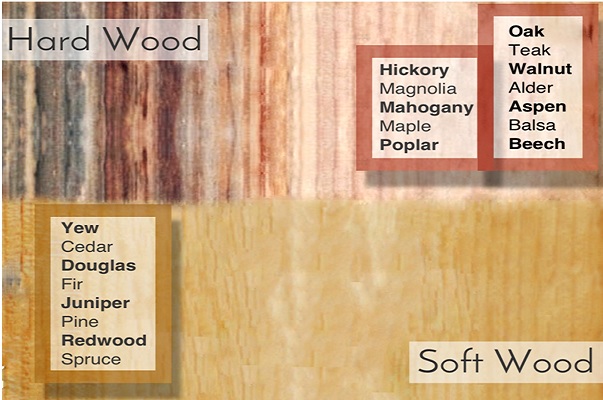In the world of custom furniture, you must have come across hard wood and soft wood. If I ask you, which one you would prefer for your favourite sofa, your answer will probably be hardwood.
So what do you think a hard wood and soft wood is?
You will intuitively think that hardwood must be harder and hence more durable compared to softwood (going by their names). However the reality is that the terms “hardwood” and “softwood” have nothing to do with hardness or softness, i.e., these terms do not indicate durability or density at all. They are actually related to tree’s reproduction, structure and origin, but not its density.
Generally most softwoods are more pliant than hardwood.
This is one of the most misunderstood aspect of wood. One of the most talked about example of this concept is that of balsa wood which, despite being literally one of the least dense (and hence softest) woods of all, is technically classified as hardwood. At the same time wood of the yew tree, which is classified as softwood, is much tougher compared to several other hardwoods.
So how do we classify Wood
We classify a wood as either hard or soft on the basis of the seeds produced by the tree or the seeds from which it grew up from. If seeds of a tree has some sort of covering when they fall from the tree in any form (in the form of a shell or fruit), then the wood of that tree will be classified as hardwood. On the other hand, if a tree produces seeds without any covering and it is in its final seed form when they fall to the ground, then the wood harvested from it is classified as a softwood.
Technically the seeds of tree that produces seeds without any form of covering is called “gymnosperm” which literally translates to “naked seed” and trees that produce covered seeds, the technical term is “angiosperm” which translates to “vessel seed” or, “seeds in a protective vessel”.
Another notable distinction is, hardwood comes from the tree that are deciduous in nature thus sheds its leaves annually(each autumn). Hardwoods are usually dense as they grow slowly, Whereas Softwoods are evergreen and are less dense.
At the microscopic level hardwood have pores like structure, which gives them its prominent grain.
Softwood do not have any visible pores and thus have light grains.
How do we determine hardness of a wood
The most common method of determining hardness of a wood is the Janka Hardness Test. Janka Hardness Test involves measuring the average amount of force required to “embed a .444-inch steel ball to half its diameter” in some type of wood, with the average used, so that the difference in hardness between heartwood and “live edge” wood doesn’t skew things too much. It is also distinguished via “side hardness” and “end hardness” (whether this test was done on the surface of a plank (side) or on the cut surface (surface of the stump), which is “end hardness”. Most of the time, the numbers you’ll see quoted are referring to side hardness.
Which wood should you choose?
The denser a wood is, the harder, stronger, and more durable it is. Most hardwoods have a higher density than most softwoods and are often more expensive and challenging to work with.
The wood applicable for our requirement depends on the purpose as different types of wood-works call for different kinds of timber. Despite the difference in terminology both hardwood and softwood are used for all sorts of building applications from structural to decorative.
for example:
Balsa belongs to hardwood category but it is less dense, soft and light and hence is a popular material for light, stiff structures in model buildings.
On the other hand Yew is perhaps the hardest of all softwood species. Its density and working characteristics are more in line with a heavy hardwood than a softwood. It is used to make cabinetry bows(archery), music instruments etc.
Below table shows the density index of different woods, clearly depicting no relation between density and type of wood.
|
Wood |
Density (lb/ft3) |
| Mahogany (Hardwood) | 31-53 |
| Teak(Hardwood) | 41-61 |
| Balsa(Hardwood) | 7-9 |
| Yew (Softwood) | 42 |
| Cedar (Softwood) | 23 |
| Pine (Softwood) | 22-35 |
Denser woods are more suitable for high quality furniture, flooring, constructions that need to last. Whereas Lighter woods are mostly used for light objects like windows, doors, home furniture etc.
Which is the softest Wood
As per the Janka test, the softest wood in the world is from Cuipo tree. You will be surprised to know that Cuipo tree wood is classified as a hardwood.
Which is the hardest wood
As per the Janka test the hardest wood in the world is from the Australian Buloke (Bull-oak) tree.Refer to image below to see a general classification for commonly used wood types.


Wood which is the raw material for making furniture is very convenient and beautiful. I enjoy wooden furniture. feeling rustic and simple.
Agree. Wooden furniture is classic. No other material compares to the beauty of wood.